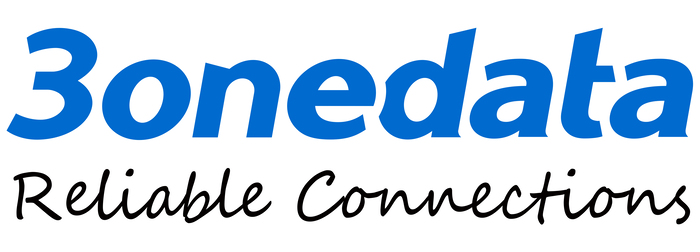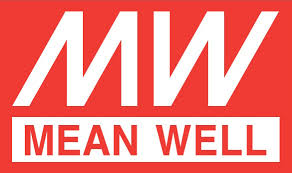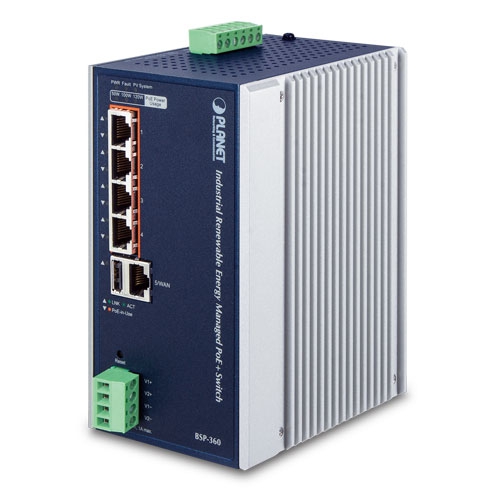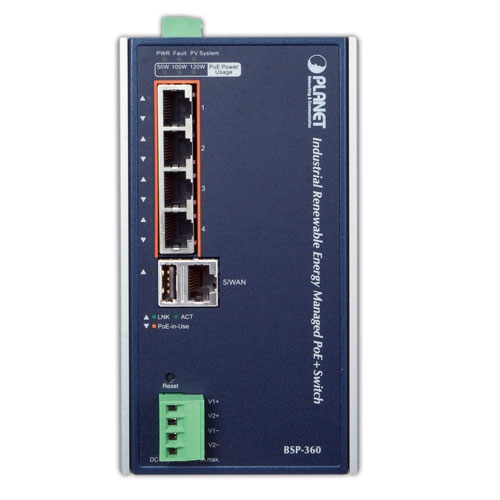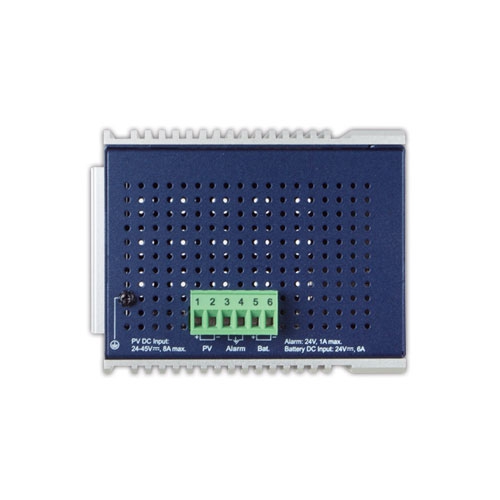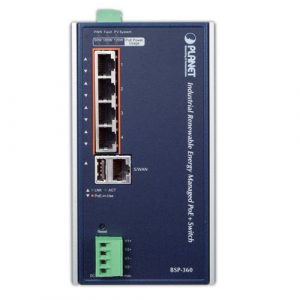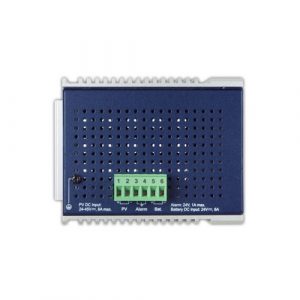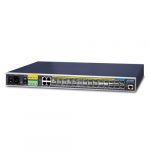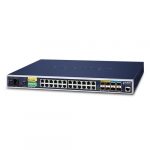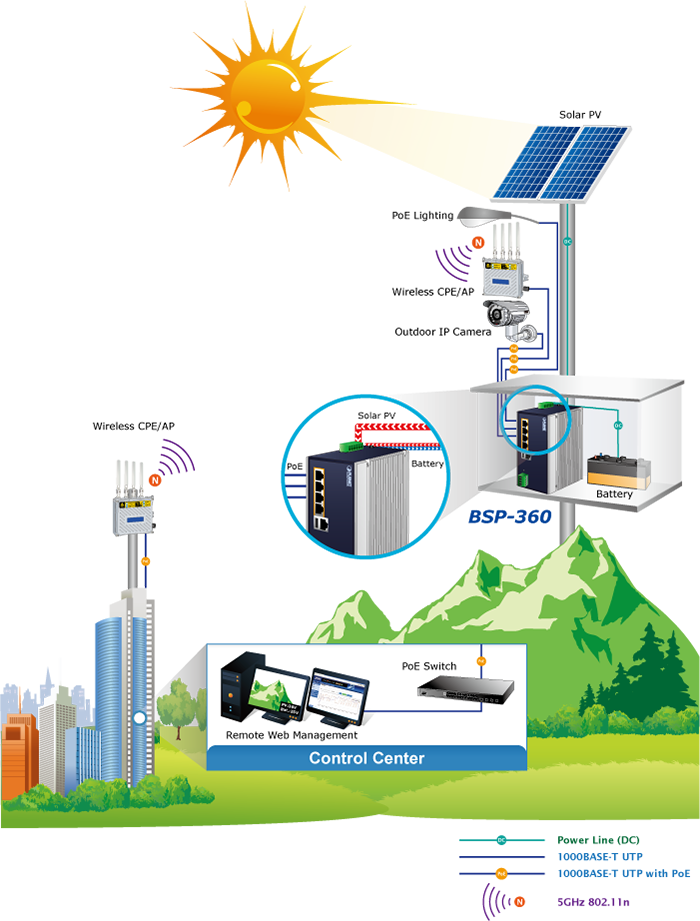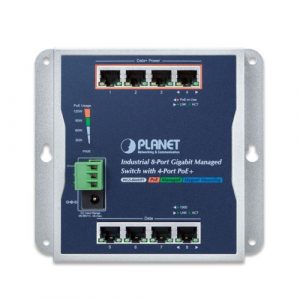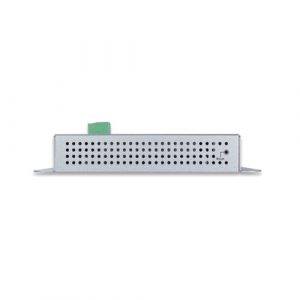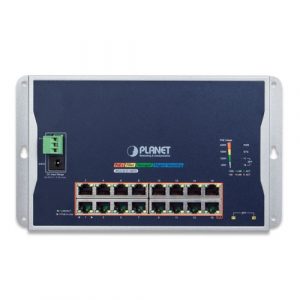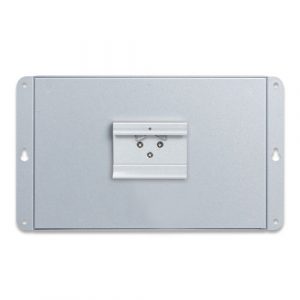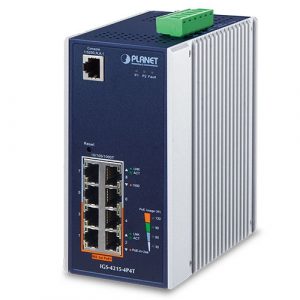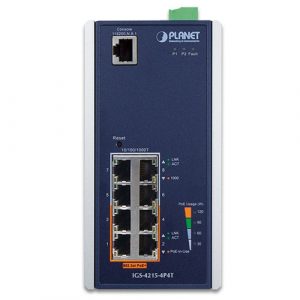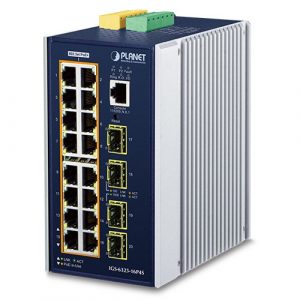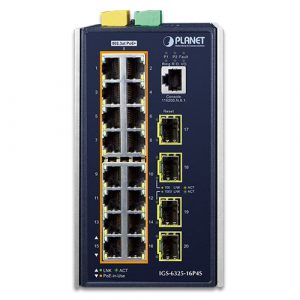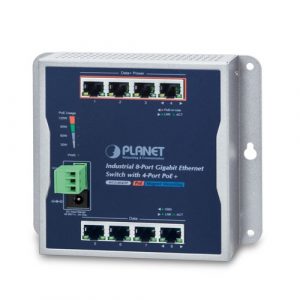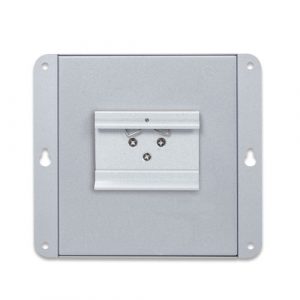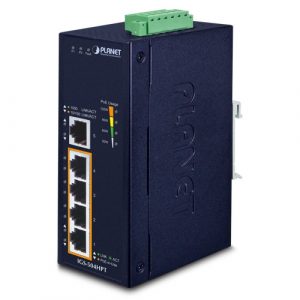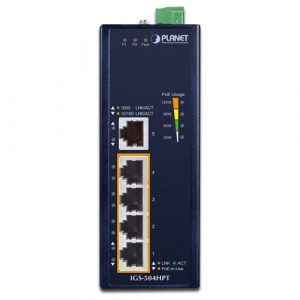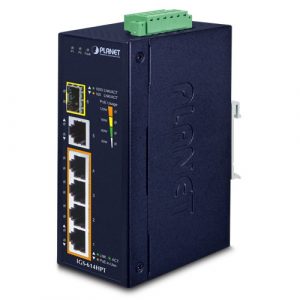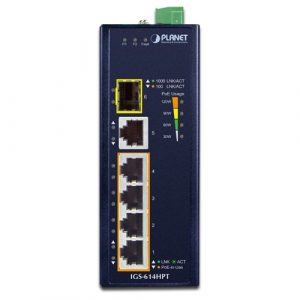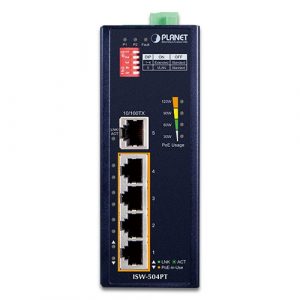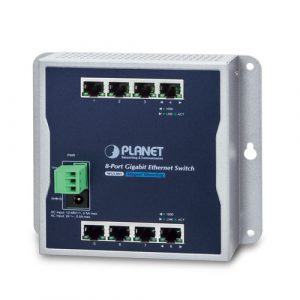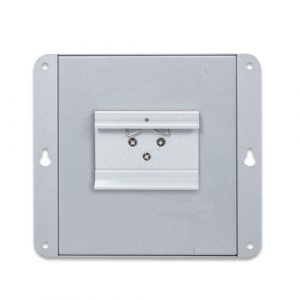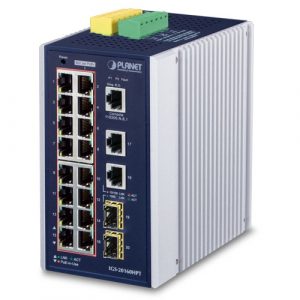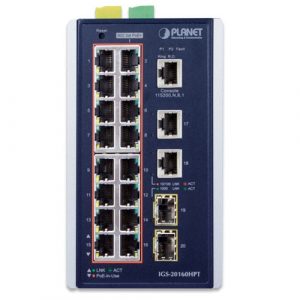BSP-360
IP30 Industrial Renewable Energy 4-Port 10/100/1000T 802.3at PoE+ Managed Ethernet Switch. (-10 to 60 degree C, 4-Port Gigabit 802.3at PoE+ injector + 1-Port Gigabit Ethernet; 24V/1A DC output, Web managemen
- Applicazioni
- DOWNLOAD
- SPECIFICHE
Descrizione
Alimentazione PoE solare per soluzione di sorveglianza wireless a lunga distanza
Lo switch BSP-360 può essere utilizzato in qualsiasi in luogo in cui non è disponibile una presa elettrica dedicata. Con cavo PoE Cat5, AP wireless e media converter SFP, è possibile controllare il consumo di energia e lo stato della batteria dall’ufficio, all’interno dell’interfaccia di configurazione del BSP-360.
Distribuzione della rete PoE Gigabit Ethernet SOHO/uso domestico
Con la sua funzionalità ampliata per uso domestico, lo switch BSP-360 facilita gli utenti SOHO/domestici nel creare una rete integrata in cui l’alimentazione viene utilizzata per la trasmissione di dati e video. Integra la tecnologia IEEE 802.3at PoE e il sistema di energia rinnovabile. Gli AP wireless e le telecamere PoE IP funzionano perfettamente con il BSP-360, che immette energia attraverso i cavi Ethernet, consentendo di implementare un ambiente di rete PoE, economico e affidabile, in maniera semplice.
Connessione wireless per applicazioni all’aperto a lungo raggio
Con le quattro interfacce PoE 802.3at/802.3af, BSP-360 consente di installare liberamente l’Access Point PoE all’aperto. Quando funziona con una coppia della trasmissione wireless, il BSP-360 può essere gestito, in modo efficiente, dal centro di monitoraggio remoto; consente una distribuzione LAN wireless più flessibile e senza la preoccupazione di avere delle prese di corrente nelle vicinanze. **
** Per ottenere le migliori prestazioni, abbinarlo a dispositivi PLANET per applicazioni bridge wireless all’esterno.
Estensione della distribuzione di rete con Media Converter in fibra
Con interfaccia di uscita a 24V DC, il BSP-360 consente di fornire alimentazione ad altri dispositivi, come il media converter IGT-905, in cui è possibile effettuare una trasmissione dati, stabile e ad alta velocità, a una rete core remota. Tramite un collegamento in fibra ottica, lo switch permette di estendere la distanza, tra il BSP-360 e il centro di controllo, fino ad un massimo di 120 chilometri.
| Hardware Specifications | |
|---|---|
| Copper Ports | LAN: 5 10/100/1000Mbps auto MDI/MDI-X RJ45 port (Port 1 to Port 5, bridge mode) WAN: 1 10/100/1000Mbps auto MDI/MDI-X RJ45 port (Port 5, gateway mode) |
| PoE Injector Port | 4 ports with 802.3af/802.3at PoE injector function (Port 1 to Port 4) |
| USB | 1 USB Type A female for setting backup |
| Power Output | 4 PoE out 51VDC; max. 30 watts per PoE port 2 DC out 24@ 1A maximum (four-pin terminal block) * The voltage of DC out is based on the battery. |
| Switch Architecture | Store-and-Forward |
| Switch Fabric | 10Gbps/non-blocking |
| Switch Throughput@64 bytes | 5.95Mpps@64 bytes |
| MAC Address Table | 8K entries |
| Shared Data Buffer | 512Kbit |
| Flow Control | IEEE 802.3x pause frame for full duplex Back pressure for half duplex |
| Reset Button | < 5 sec: System reboot > 5 sec: Factory default |
| LED Indicators |
3 LEDs for System and Power: Green: Power Red: Fault Green: System 4 LEDs for PoE Copper Ports (Port 1~Port 4): Green: LNK/ACT Orange: PoE-in-use 1 LED for 10/100/1000T Copper Port (Port 5): Green: LNK/ACT 3 LEDs for PoE Power Usage (W) Orange: 50, 100 and 120W |
| Connector | Removable 6-pin terminal block Pin 1/2 for PV panel; Pin 3/4 for alarm; Pin 5/6 for battery |
| Alarm | 1 digital output (DO): Level 0: -24V~2.1V (±0.1V) Level 1: 2.1V~24V (±0.1V) Open collector to 24V DC, 100mA max. |
| Power Requirements | PV in: 24~45V DC Battery in/out: 24V DC |
| Power Consumption/ Dissipation | 5.04 watts, 17.1BTU (Standby without PoE function) 6.96 watts, 23.7 BTU (Full loading without PoE function) 135.36 watts, 461.5 BTU (Full loading with PoE function) |
| Dimensions (W x D x H) | 89 x 107 x 152 mm |
| Weight | 1026g |
| ESD Protection | 6KV DC |
| Enclosure | IP30 aluminum case |
| Installation | DIN-rail kit and wall-mount ear |
| Power over Ethernet | |
| PoE Standard | IEEE 802.3af/802.3at Power over Ethernet PSE |
| PoE Power Supply Type | End-span |
| PoE Power Output | Per port 51V DC, 275mA. Max. 15.4 watts (IEEE 802.3af) Per port 51V DC, 535mA. Max. 30 watts (IEEE 802.3at) |
| Power Pin Assignment | 1/2 (+), 3/6 (-) |
| PoE Power Budget | 120 watts (PoE consumption + DC out and depending on power input) |
| Max. Number of Class 2 PDs | 4 |
| Max. Number of Class 3 PDs | 4 |
| Max. Number of Class 4 PDs | 4 |
| Electrical Characteristics | |
| System Voltage Rating | 24V DC |
| Maximum Input Current | 6A (System with Over Current Protection) |
| Max. Solar Array VOC | 60V DC |
| Max. Operating Voltage | 45V DC |
| Total Current Consumption | While operating -32mA At idle -11mA |
| High Temperature Shutdown | 100 degrees C (disconnect solar and loading) 80 degrees C (reconnect solar and loading) |
| Battery Charging Characteristics | |
| Charge Algorithm | The design presently uses ‘perturb and observe’ algorithm for MPP tracking. |
| Maximum Output Current | 6A |
| Lead Acid Battery (Default Setting) | ± 60 mV/degrees Celsius for lead acid type batteries; charge cut-off @ 55 degrees C (Temperature compensation baseline@ 25 degrees C) |
| Float Charge Voltage | DC 27.2V (26.0~30.0V) |
| Absorption Charge Voltage | DC 29.2V (28.0~32.0V) |
| LVD (Low Voltage Disconnection) | DC 22.2V (21.0~25.0V) |
| LVR (Low Voltage Reconnection) | DC 22.4V (23.0~27.0V) |
| Router Features | |
| Internet Connection Type | Shares data and Internet access with users, supporting the following internet accesses:
|
| Firewall | NAT firewall with SPI (Stateful Packet Inspection) Built-in NAT server supporting Port Forwarding, and DMZ Built-in firewall with IP address/MAC address/Port/ URL filtering Supports ICMP-FLOOD, UDP-FLOOD, TCP-SYN-FLOOD filter, DoS protection |
| Routing Protocol | Static/Dynamic (RIP1 and 2) routing |
| VPN Pass-through | PPTP, L2TP, IPSec, IPv6 |
| LAN | Built-in DHCP server supporting static IP address distribution Supports UPnP, Dynamic DNS Supports IGMP Proxy Supports 802.1d STP (Spanning Tree) IP/MAC-based bandwidth control |
| Management | |
| Management Interface | Setting up of system/management functions Web firmware upgrade SNMP trap for alarm notification of events |
| PoE Management | Power limit by consumption and allocation PoE admin mode Per port power schedule Per port power enable/disable Power feeding priority Current per port usage and status Total power consumption PD alive check Scheduled power recycling |
| Battery Management | Current battery usage status Low voltage cut-off protection |
| Standards Conformance | |
| Regulatory Compliance | FCC Part 15 Class A, CE |
| Standards Compliance | IEEE 802.3 10BASE-T Ethernet IEEE 802.3u 100BASE-TX Fast Ethernet IEEE 802.3ab 1000BASE-T Gigabit Ethernet IEEE 802.3x Flow Control and Back Pressure IEEE 802.1D Spanning Tree Protocol IEEE 802.3af Power over Ethernet IEEE 802.3at Power over Ethernet Plus RFC 768: UDP RFC 791: IP RFC 2068 HTTP RFC 1157: SNMP v1 RFC 1902: SNMP v2c RFC 5424: Syslog |
| Environment | |
| Operating | Temperature: -10 ~ 60 degrees C Relative Humidity: 5 ~ 95% (non-condensing) |
| Storage | Temperature: -10 ~ 70 degrees C Relative Humidity: 5 ~ 95% (non-condensing) |


